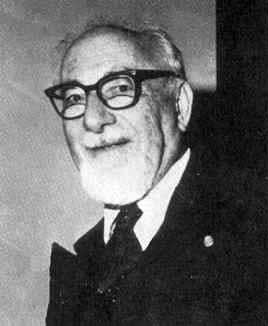
Francesco Giacomo Tricomi
 المؤلف:
F G Tricomi
المؤلف:
F G Tricomi
 المصدر:
La mia vita di matematico attraverso la cronistoria dei miei lavori (Bibliografia commentata 1916-1967)
المصدر:
La mia vita di matematico attraverso la cronistoria dei miei lavori (Bibliografia commentata 1916-1967)
 الجزء والصفحة:
...
الجزء والصفحة:
...
 20-8-2017
20-8-2017
 798
798
Born: 5 May 1897 in Naples, Italy
Died: 21 November 1978 in Turin, Italy

Francesco Tricomi studied first at the University of Bologna, then at the University of Naples. His first academic appointment was to lecture at Padova, then he moved to the University of Rome.
The University of Florence offered Tricomi a chair of mathematics which he accepted but, after a few years, he moved again to take up the chair of mathematics at Torino. In fact before he moved to Torino he had already published a paper in 1923 which was to become very famous. In this paper he studied the theory of partial differential equations of mixed type, in particular the equation
yuxx + uyy = 0,
now known as the 'Tricomi equation'. The equation became important in describing an object moving at supersonic speed. Of course there were no supersonic aircraft in 1923 but the equation was to play a major role in later studies of supersonic flight.
Tricomi's time in Torino was affected by World War II and his work was interrupted for a time. Then, a few years after the end of the war, he was involved in the Bateman project. In 1946 Bateman died and Erdélyi headed a team, which included Magnus and Tricomi, working at the California Institute of Technology to publish the vast range of material left by Bateman. The team produced 3 volumes of Higher Transcendental Functions and 2 volumes of Tables of Integral Transforms.
In 1950 Tricomi returned from the United States to Torino to continue his remarkable research output. Tricomi's autobiography [1] list 300 papers, while a further 46 are listed in [6]. These papers cover a vast range of subjects including singular integrals, differential and integral equations, pseudodifferential operators, functional transforms, special functions, probability theory and its applications to number theory.
As well as having the 'Tricomi equation' named after him, there are also special functions called 'Tricomi functions'.
Tricomi was an editor of Aequationes Mathematicae from the time the journal was founded until his death. The editors described him as:-
A forthright man, outspoken opponent of dictatorships of all colours, of sloppiness, of abstraction for abstraction's sake, and of the 'publish or perish' syndrome, his interests went far beyond mathematical research. Here we mention only his interest in the teaching of mathematics and in expository work, which led him to write several excellent textbooks, eventually translated from their original Italian to English, French, German and Russian.
The fine books refered to in this quotation were certainly vastly superior to that suggested by the modest comment Tricomi wrote in the preface of one of them:-
Maybe I have not succeeded to make difficult things easy, but at least I have never made an easy subject difficult.
Tricomi had a deep interest in problems concerning the history of mathematics and he published many important articles on this topic. In fact, references to articles on Riemann, Hadamard, Enriques and Fubini written by him appear in this Archive.
His influence on mathematics goes well beyond the impressive results of his research. His writings have made an important contribution towards the present development of science. As the editors of Aequationes Mathematicae write:-
... the problems ... which he has solved and the theories which he has initiated and others have continued to work on, will keep his name alive. His passing away is a great loss to the international mathematical community.
Books:
- F G Tricomi, La mia vita di matematico attraverso la cronistoria dei miei lavori (Bibliografia commentata 1916-1967) (Padova, 1967).
Articles:
- G C Dong and M Y Chi, Influence of Tricomi's mathematical work in China, in Mixed type equations (Leipzig, 1986),
- G Fikera, Francesco Giacomo Tricomi (on the ninetieth annversary of his birth) (Russian), Uspekhi Mat. Nauk 42 (3)(255) (1987), 203-211.
- G Fichera, Francesco Giacomo Tricomi, in Mathematical analysis (Leipzig, 1985), 6-31.
- G Fichera, Francesco Giacomo Tricomi (Italian), Atti Accad. Sci. Torino Cl. Sci. Fis. Mat. Natur. 114 (1-2) (1980/81), 37-48.
- G Fichera, Francesco Giacomo Tricomi (Italian), Atti Accad. Naz. Lincei Rend. Cl. Sci. Fis. Mat. Natur. (8) 66 (5) (1979), 467-483.
- S G Mikhlin, On Tricomi's works on integral equations, in Mixed type equations (Leipzig, 1986), 195-204.
- U Richard, Francesco Giacomo Tricomi (Italian), Boll. Un. Mat. Ital. A (6) 1 (1) (1982), 159-170.
- F G Tricomi, Principles and maxims from a notebook of Francesco G Tricomi (1897-1978) (Italian), Archimede 31 (1-2) (1979), 15-16.
 الاكثر قراءة في 1895to1899
الاكثر قراءة في 1895to1899
 اخر الاخبار
اخر الاخبار
اخبار العتبة العباسية المقدسة


